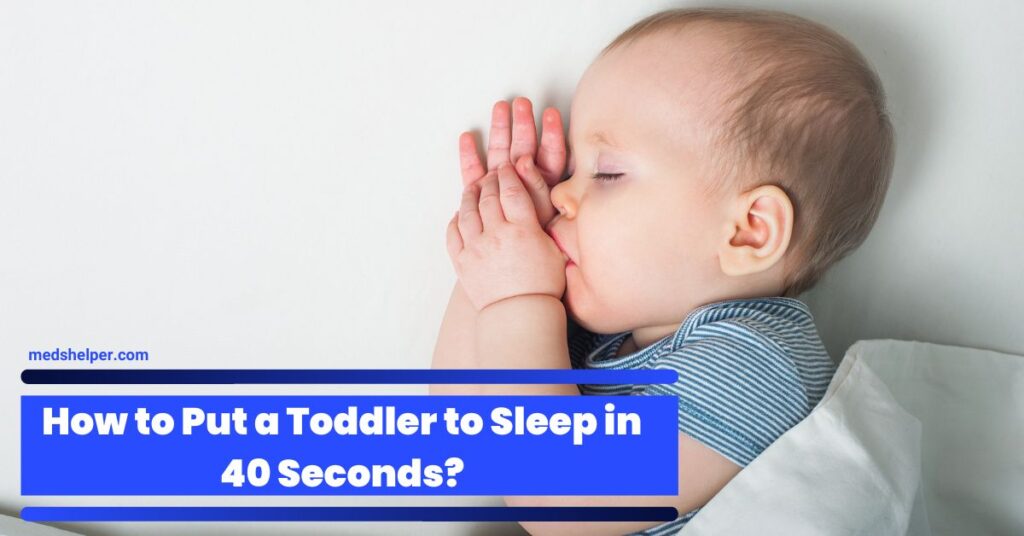If you are curious about the type of baby that you have, it is easy to tell by their sleeping habits. The first type of baby can sleep through the night. He/she sleeps between 9 p.m. and 6 a.m. without getting up. This is called a “good slumber.” The second type of baby does not sleep through the night.
On such occasions, he/she will wake up every two hours crying. The term “difficult to the sleeper” describes this. What makes these two types different? Both are simply tired. A good sleeper has more energy than a poor sleeper.
Follow these tips, and get to know how to put a toddler to sleep in 40 seconds
How Much Time Should Be Spent Getting A Toddler To Sleep?
Table of Contents
Most children will fall asleep within 20-30 mins of getting into bed. If your child remains awake for more than 20-30minutes after lights go out, you may need to adjust bedtime for a couple of weeks.
What Are Some Causes Of A Baby Not Falling Asleep?
There are many reasons why a child doesn’t fall asleep. Here are some:
- Too much noise
- Too much light
- Too much movement
- Too many distractions
- Weather disasters
- Too much food
- Too much excitement
- Too much crying
- Too much cuddling
- Too much rocking
- Too much talking
- Too much playing
- Too much walking
Techniques: How to put a Toddler to Sleep in 40 Seconds?
Let’s see how to put a toddler to sleep in 40 seconds. These techniques will help you a lot. Keep reading.
1. Dimming the Light Is a Good Idea
Bright light wakes up babies, just like adults. The room can be light. However, you will still need to see your baby at night and be able to check on him/her while he is asleep.
2. Make certain that your baby can sleep in a secure environment
Your baby should lie on their back on a firm, ventilated mattress. Place the crib in your living room, so the baby is always within reach. Keep your crib tidy. You don’t need toys in your crib. They could be hazardous.
A tight-fitting mattress cover and a baby blanket should not be found in the baby’s crib. It is okay to use a bedtime pacifier. Babies sometimes need to have the teat in their mouth before they can get to sleep.
3. The Tissue Trick
This is an old wives tale, but it works well to get your baby to sleep in as little as 4 seconds. To soothe your baby, gently drag a dry tissue across their forehead.
4. Red Light
Research shows that blue light helps keep us awake. Blue light reduces melatonin and stimulates cortisol, which can negatively impact sleep. The sleep hormone melatonin is essential for our babies. Your baby will sleep faster and longer under red light than with blue.
5. Utilize Calming Lotions before Bed
Massage baby lotions on your skin after a relaxing bath. Studies have shown that calming lavender creams make it easier for newborns to fall asleep. You can use them before bedtime, during naptime, or whenever your baby is struggling to sleep.
6. Sing Or Recite Your Bedtime Story
It’s well-known that babies are more likely to fall asleep when they hear a lullaby or read a bedtime story. There is a science to support this theory! In a study published by Pediatrics, it was found that babies who were read a story fell asleep much faster than those who listened to the recording.
7. Follow A Consistent Schedule
You should ensure that your toddler wakes up every morning at the same time and goes to bed each night at the exact time. Research shows that toddlers are more likely to sleep well with a set bedtime.
8. Plan Your Dinnertime Properly
Are your children asking for snacks after getting out of bed? It’s essential to ensure your child eats slowly, so they are not hungry again after their bedtime routine. Avoid this problem by allowing dinner at least an hour before bed.
9. Running Water
Spas have a relaxing effect. You’ll hear waterfalls, rain, and babbling brooks. This is also true for your infant. You can help your infant fall asleep quicker if running water is played.
10. Chant
Chanting is another beautiful relaxation technique that tribes have used for thousands of years. This will allow your baby to relax. Chanting to your baby allows them to be soothed and channeled to sleep faster using this ancient tradition.
11. Lightly Stitches Their Neck or Head
A gentle stroke on your baby’s forehead or back can help them fall asleep quicker. This can relax them and make them sleepy. It can also be used to soothe their distress. You can make this a routine for your baby’s bedtime and help them drift off to sleep faster.
12. Manage Nightmares
Nightmares, common in children as young as 2, 3, and 4, can be frightening. You can provide shelter under your sheets if your toddler has a nightmare and wants to escape.
It’s better to let them return to bed once they are calmed down. Make sure to surround them with comfort to help them feel safe and to teach them to fall asleep independently.
13. Find Your Best Friend
You can help your toddler get to sleep by getting him a stuffed animal. You can have your child complete each routine step with the doll. Then, repeat this step for your child.
14. Repetitive Movement
Isn’t it wonderful to watch your baby fall asleep when the seat is on in the car?
Baby’s love is the key to getting your baby to sleep fast. While you might not be able to jump in the vehicle to put your baby to sleep, there are still ways to mimic that motion.
This purpose-built baby rocker was explicitly created for this purpose. They mimic the feeling of being in the back seat of a car and the ups and downs of driving. Your baby may also enjoy being gently held and moved from one side to the other to encourage them to drift off.
15. Switch Off The Screens
Televisions and games, tablets, computers, and smart phones. This can be a hard one. Electronic devices can help your kids settle down and give dad and mom a break. However, the connection between all these screens and sleep can be powerful.
16. A Nap Should Be Taken
The needs of your child will vary. Some toddlers may not need naps, while others might.
Many experts recommend that you continue to take a nap until the age of 5. Aim to take one to three hours of sleep every day for toddlers aged 1 through 3.
If your child skips their naps while still needing them, they’ll likely be cranky and throw tantrums. This can make bedtime more difficult for both of you.
It is best to put your little one to bed at a reasonable hour if they don’t seem to need a nap. Most toddlers need between 12-14 hours of sleep. Avoid naps and ensure that your child gets enough sleep each night.
Frequently Ask Questions
Tips for Putting Toddlers to Sleep without a Bottle?
You can break this cycle by slowly decreasing how much milk you put in your bottle. In a matter of weeks, you can reduce the amount by approximately one ounce per night. The bottle can be thrown out if you only have one ounce of milk before bed.
Is It Too Soon To Start Bedtime Lessons For My Toddler?
Are you noticing your toddler getting up out of their bed at night to go to sleep when they should? It doesn’t matter if it seems too late or not possible to teach your toddler how to sleep trains. Even though sleep training is more accessible with infants, you can still start it later.
In General, How Long Does It Take To Teach A Toddler To Fall Asleep?
It depends on the method used. It depends on the way you use it. The “extinction,” or cry-it-out, process is generally fast. However, it can be difficult for some to overcome the initial crying and stubbornness. While the pick-up/put-down method can seem gentler for some, it can take a while.
In Two Years, Has There Been Any Sleep Regression?
A regression could occur if your child resists napping or has trouble falling asleep at night.
Is Toddler Sleep Training Possible?
Yes, you can teach your toddler how to get good sleep. You could reward your toddler with stickers each night so they can sleep on their feet.
How to Put Hyper Babies to Sleep?
- Swaddling for infants
- Massage
- Any light, repetitive movement, such as swinging or swaying
- Feeding (not when babies are in bed, but until they feel sleepy)
- Dimming lights
- Playing soft music or soothing sounds from an app or white noise device.

Conclusion
I hope you enjoyed this article (how to put a toddler to sleep in 40 seconds). These tips can help you put your baby down in just 40 seconds. While every baby is different, the principles are simple. For more information about any sleep disorder, you can visit the home page of the website. Good luck!


